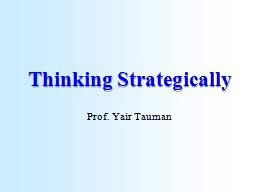PPT-Thinking Strategically Prof.
Author : anya | Published Date : 2023-09-18
Yair Tauman 2 The Right Game From LoseLose to Win Win In the early 1990s the US automobile industry was locked into an all too familiar mode of destructive competition
Presentation Embed Code
Download Presentation
Download Presentation The PPT/PDF document "Thinking Strategically Prof." is the property of its rightful owner. Permission is granted to download and print the materials on this website for personal, non-commercial use only, and to display it on your personal computer provided you do not modify the materials and that you retain all copyright notices contained in the materials. By downloading content from our website, you accept the terms of this agreement.
Thinking Strategically Prof.: Transcript
Download Rules Of Document
"Thinking Strategically Prof."The content belongs to its owner. You may download and print it for personal use, without modification, and keep all copyright notices. By downloading, you agree to these terms.
Related Documents














